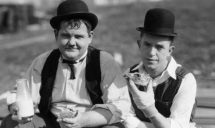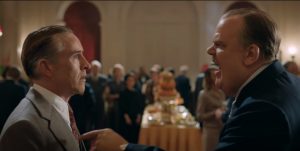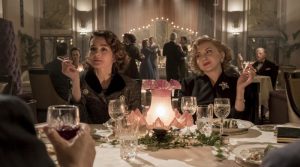Stan & Ollie

It's another fine mess...
(Directed by Jon S. Baird) (2019)
“Stan’s cry, or the frequent sight of Oliver, prostrated and turning up his face in speechless appeal, may seem unfunny at first acquaintance, but gradually grow upon one until they are hilarious, irresistible, looked-for, and cherished.”* And once you watch a few of Laurel and Hardy’s short and longer films (try Way Out West (1937), which we watched to get in the mood for the film under review, or Laughing Gravy (1931), which you can see on YouTube), the appeal starts to soak in: you sense something deep and loving under the chaos, peevishness, and incompetence – whether in the odd pace-changes from the manic to the introspective, as in a Ren and Stimpy cartoon – or the peculiar and destructive havoc they wreak à la the Dumb and Dumber franchise – or the “funny and astonishingly beautiful dance duets, moving ever more ecstatically into their private world…“** (see below).
Which brings us to this account of the team’s dog days in post-war Britain. Long after the heady days when they were among the top ten box office draws, Stan & Ollie presents the lads well past their prime, reprising their routines on the minor music hall circuit. Laurel, the soulful, creative one (Steve Coogan) still simmers with resentment over the time when, at their peak, Hardy (John C. Reilly) failed to support him in his fight for a better deal with studio head Hal Roach (Danny Huston) – Ollie is vexed that the schedule for their comeback film about Robin Hood seems so vague and fluid. We get the highs and lows of the tour, the spats, the run of the PR mill, the heart murmurs and heart-warming reconciliation, and that’s about it.
There’s really nothing exceptional about the film – even the well-made scenes of post-war Britain and Old-Hollywood seem fake, and with such a thin and predictable plot, filled with mawkish sentiment, one finds oneself hankering for the one-reeler where the real Laurel & Hardy deliver a piano. That means the actors must come to the fore, and of course here the two leads have to carry the piece, but there’s a problem: Steve Coogan, for all his comic brilliance, is not a good straight actor. To put it bluntly, his response to the less-than-heavy dramatic demands of the bitter, alcoholic Stan Laurel, is to play a querulous customer in a Lancashire pie shop. Reilly has natural charm, but the role is one-dimensional. Of the supporting cast, most are ‘types’; but we liked Nina Arianda as Stan’s exotic wife, Ida – she had a good double-act going with Ollie’s missus, Lucille (Shirley Henderson) – and Rufus Jones, obsequious and shifty as their English booking-agent, Bernard Delfont.
About 40 minutes in, The TVC reviewing staff whispered to each other: “We’ve made a dreadful mistake.” The film actually improved after that, but by then, we viewers doubtless had come to accept it in its own limited terms. Neither noxious, nor incompetent, nor opportunistic, it had some nice things in it, certainly, but ultimately ’tis bland and inconsequential as dust.
Now let’s cheer up and watch the original cabaret turn from Way Out West, which Coogan and Reilly do quite nicely in Stan & Ollie (and then again, but not as well):
Leave a comment...
While your email address is required to post a comment, it will NOT be published.




0 Comments